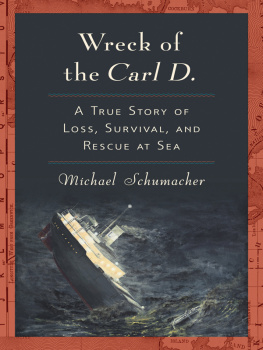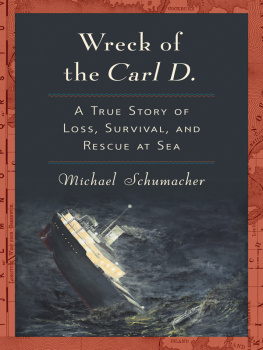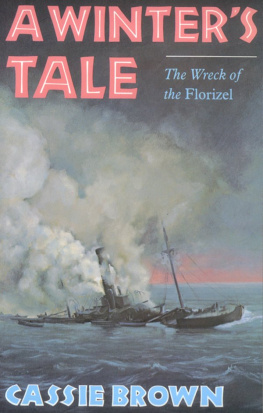
WRECK OF THE CARL D.
BY THE SAME AUTHOR
Reasons to Believe: New Voices in American Fiction
Creative Conversations: The Writers Complete Guide to Conducting Interviews
Dharma Lion: A Biography of Allen Ginsberg
Crossroads: The Life and Music of Eric Clapton
There but for Fortune: The Life of Phil Ochs
Francis Ford Coppola: A Filmmakers Life
Mighty Fitz: The Sinking of the Edmund Fitzgerald
Mr. Basketball: George Mikan, the Minneapolis Lakers, and the Birth of the NBA
WRECK OF THE CARL D.
A TRUE STORY OF LOSS, SURVIVAL, AND RESCUE AT SEA
MICHAEL SCHUMACHER

Copyright 2008 by Michael Schumacher
All rights reserved. No part of this book may be used or reproduced in any manner whatsoever without written permission from the publisher except in the case of brief quotations embodied in critical articles or reviews.
For information address Bloomsbury USA, 175 Fifth Avenue, New York, NY 10010.
Published by Bloomsbury USA, New York
Title page photo courtesy Presque Island Historical Museum
Map by Patrick McDonald
All papers used by Bloomsbury USA are natural, recyclable products made from wood grown in well-managed forests. The manufacturing processes conform to the environmental regulations of the country of origin.
LIBRARY OF CONGRESS CATALOGING-IN-PUBLICATION DATA
Schumacher, Michael.
Wreck of the Carl D. : a tr ue story of loss, survival, and rescue at sea / Michael Schumacher.1st U.S. ed.
p. cm.
Includes bibliographical references and index.
eISBN: 978-1-60819-248-9
1. Carl D. Bradley (Ship) 2. ShipwrecksMichigan, Lake. 3. Survival after airplane accidents, shipwrecks, etc.Michigan, Lake. I. Title.
G530.C2958S38 2008
917.74dc22
2008014242
First U.S. Edition 2008
1 3 5 7 9 10 8 6 4 2
Typeset by Westchester Book Group
Printed in the United States of America by Quebecor World Fairfield
To the crew of the Carl D. Bradley
and
to those who knew and loved them
CONTENTS

Tuesday, November 18, 1958
The wind, strong and out of the southwest, blows in, and temperatures start to fall.
The people of the small town of Rogers City, Michiganor at least those who give this kind of thing a second thoughtregard the change in weather with mixed feelings. Deer-hunting season is only in its fifth day, and the predicted colder temperatures, along with the possibility of snow, are more than welcome to those wielding shotguns and rifles. They trudge around the heavily wooded area behind the massive limestone quarry that is Rogers Citys identity and livelihood. Snow, no stranger to the area this time of year, will make the deer much easier to track. In these parts, deer hunting transcends the idea of sport and recreation; bringing down an eight-point buck is the first sentence of a story that will be embellished and retold until someone comes up with something better.
Nature has created a region for outdoor sports, and the residents of Rogers City regard their surrounding beauty the way most Europeans admire the frescoes in surrounding cathedrals and basilicas. The lakes and woods provide them with their livelihoods and recreation; people here hunt and fish the way people in downstate Michigan might attend a concert or go to the opera, head out to Briggs Stadium for a ball game, spend an afternoon or evening at the movies, or gather at nightclubs. And why not? This is the region where downstaters retreat, where they take summer vacations to escape the boundaries of the city. Rogers City has Lake Huron for its northern boundary.
There are days when the lake is the most beautiful place on Earth, when you can stand near the shoreline and the water seems to move toward you like a welcoming gesture. The midmorning sun, overhead and reflected on the water, is such that you have to squint just to look straight ahead. Sometimes you might hear birds, geese or gulls or others, moving with disinterest over the water, or you might hear sounds of the wind, coming from as if inside your head, but if its really quiet, you can make yourself believe youre hearing the sound of a promise. And you take it to heart. This is what the residents of Rogers City understand.
The hunters are out today. Their prey, normally in such plentiful supply as to provide entertainment to families driving out to the woods during the summertime and making a game of spotting and counting them, now know better than to wander into view; they wont feed until dusk. The day is warm enough that the men and women looking for them work up a sweat as they make their way through the woods. Every so often, someone squeezes off a shot.
A layer of fresh snowa good couple of inches of itwould help... Maybe the weather is about to cooperate.
Rogers City, located in the northern tip of lower Michigan, is a clean, quiet city, far removed from the concerns of such larger cities as Lansing, Flint, Ann Arbor, Grand Rapids, or Detroit. The people in those places live in ways that are foreign to the folks in Rogers City or any of the other tiny communities along the shore of Lake Huron. Rogers City has all of one stoplight; a main drag displaying almost all of the citys businesses; and neat, tidy houses lining neat, tidy streets. Residents here can go to bed without locking themselves into their houses or worrying about strange sounds outside their windows. Theyre friends with the butcher trimming their steaks at the corner store, neighbors of the guys delivering their mail or cutting their hair. Everybody knows everybody, and the prospects of gossip are probably as responsible for keeping people on the level as any law passed downstate in the Capitol building.
The 3,873 residents of Rogers City can thank the Michigan Limestone and Chemical Company, a division of the U. S. Steel Corporation, and, by extension, the Bradley Transportation Company, for their comfort. The limestone quarry, the worlds largest, sprawls out for miles at the citys southern border, and among the workers mining the stone, crushing and processing it at the plant, and moving it to ports around the Great Lakes, almost everyone in town is connected, in one way or another, to the business. Hundreds work at the plant, while nearly 350 others work on the fleet of nine massive self-unloading boats hauling the product. Aside from going into the service or attending college in another town, a young man graduating from City High has two basic choices for the future: he can work at the plant, or he can go sailing on the boats.
To those families with loved ones working on the stone boats, todays changing weather pattern is cause for notice. Its late in the shipping season, with Thanksgiving only nine days away. Most of the boats will be laid up for the winter in days, and the men will be home for some long-overdue time with their families. As far as anyone in Rogers City is concerned, a little snow is one thing, but there is no good reason for a late-season storms complicating shipping schedules, or causing delays or anxiety.
Betty Kowalski, wife of one sailor and sister of four others, cant help but notice and be slightly irritated by the wind.
The day started out breezy and warm, with temperatures climbing to a balmy sixty-six degrees, and Betty used the unseasonably mild conditions to hang her laundry on lines outdoors. Now the wind is twisting her carefully pinned clothes into a bollixed-up mess, which is precisely the kind of distraction she can do without. Less than a week shy of her twenty-first birthday, Betty already has two tiny kids to keep her busy, and with her husband Bobs boat, the T. W. Robinson , due later in the evening, she needs to finish a number of household chores and get the kids cleaned up and over to her parents house before she drives out to pick him up.
Next page













